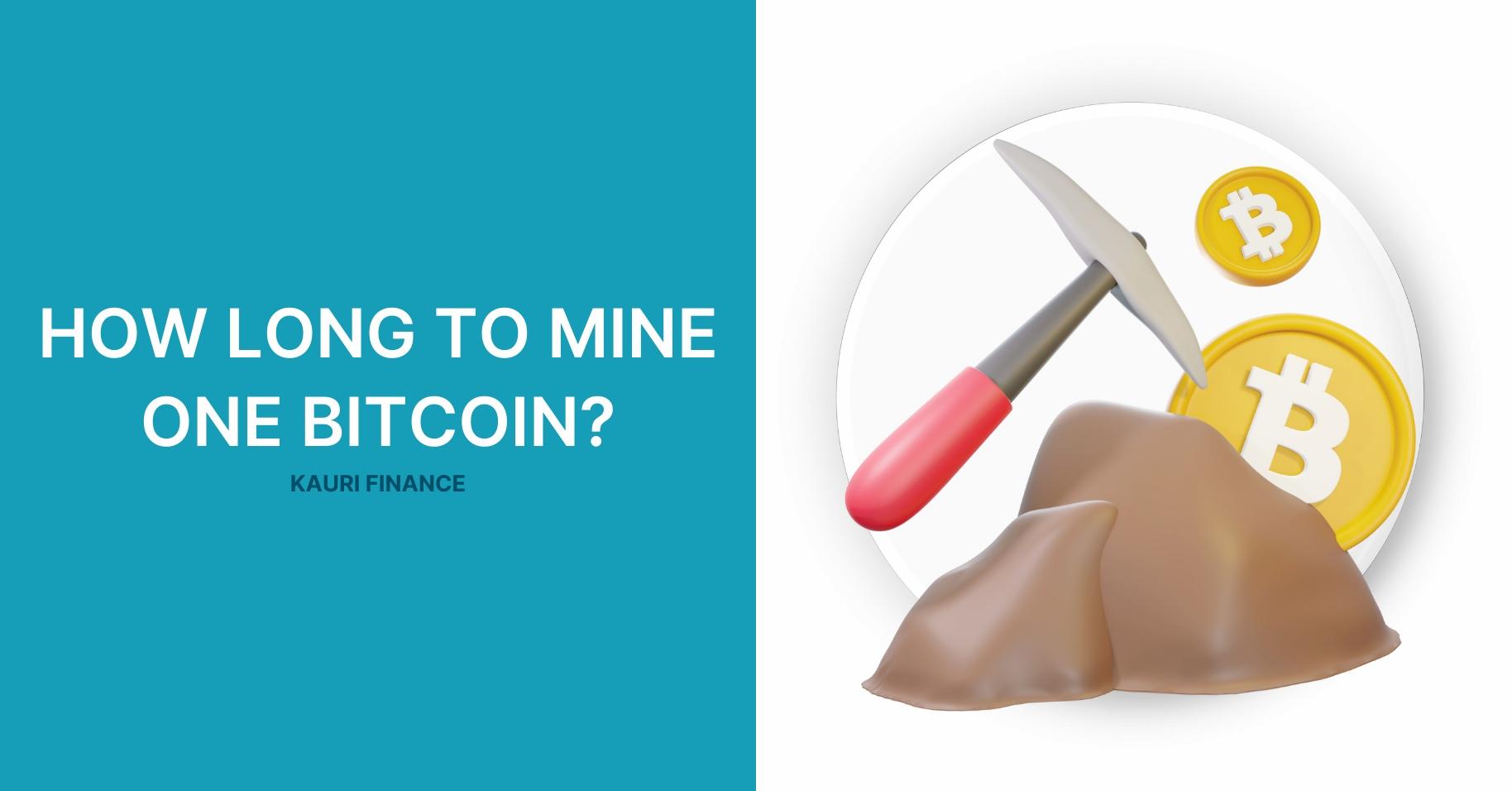
How Long to Mine One Bitcoin?
- What is Bitcoin Mining?
- Bitcoin Supply Limit
- Mining Process
- Factors Determining Mining Time
- Block Rewards and Mining Time
- Mining Pools and Their Role
- Types of Mining Pools
- Feasibility and Difficulties
- Comparison of Solo Mining vs. Pool Mining
- Alternative Mining Options
- Risks and Benefits Associated with Cloud Mining
- Conclusion

Bitcoin, the first decentralized digital currency, revolutionized the financial world by introducing a system where monetary transactions can be conducted directly between users without the need for a centralized authority. This decentralized nature is powered by blockchain technology, which ensures transparency, security, and integrity in all transactions. Bitcoin not only serves as a means of exchange but also has emerged as a significant store of value, often compared to digital gold.
The process that keeps this system functioning smoothly is known as Bitcoin mining. Mining is critical as it performs two essential functions: it secures the network by verifying transactions and prevents double-spending, and it introduces new Bitcoins into circulation, adhering to a predefined issuance rate.
What is Bitcoin Mining?
Bitcoin mining is the process by which transactions are verified and added to the public ledger, known as the blockchain. It also refers to the method through which new Bitcoins are released. Anyone with access to the internet and suitable hardware can participate in mining. The mining process involves compiling recent transactions into blocks and trying to solve a computationally difficult puzzle. The participant who first solves the puzzle gets to place the next block on the blockchain and claim the rewards, which include newly released Bitcoin and transaction fees paid by users.
Bitcoin Supply Limit
The total supply of Bitcoin is capped at 21 million coins, a decision made by its anonymous creator, Satoshi Nakamoto, to introduce scarcity to the digital currency, which theoretically will help increase its value over time as demand grows. Approximately every four years, the Bitcoin network undergoes a halving event, which cuts the number of bitcoins miners can earn per block in half. This process not only prolongs the mining timeline but also can have a profound impact on Bitcoin’s price due to the reduced rate at which new coins enter circulation.
Currently, over 19.5 million Bitcoins have been mined, with the remaining portion expected to be mined out by the year 2140. This finite supply and the decreasing issuance rate contribute significantly to Bitcoin’s valuation and its appeal as an investment.
Mining Process
- Search for the Target Hash: The core of Bitcoin mining revolves around the search for a specific target hash, which validates a block of transactions and adds it to the blockchain. Miners use high-powered computers to solve complex mathematical problems that involve hashing. The goal is to find a hash that meets certain criteria set by the network's difficulty level. This difficulty adjusts every 2,016 blocks (approximately every two weeks) to ensure that one block is mined approximately every 10 minutes, regardless of the total computational power of the network.
- Role of Hashing and SHA-256: Hashing is the process of converting an input of any length into a fixed size string of text, using a formula. In the case of Bitcoin, the SHA-256 algorithm — a part of the SHA-2 family of cryptographic hash functions designed by the NSA — is used. Every time a transaction is made, it is hashed, and this hash is processed to produce the new hash of the block. This ensures not only security and integrity of data but also makes it computationally demanding and energy-intensive.
- Bitcoin Halving Impact: Approximately every four years, or every 210,000 blocks, the reward for mining a block is halved, an event known as "Bitcoin halving." This mechanism reduces the number of new Bitcoins generated by the network, thereby slowing down inflation and adding scarcity to the ecosystem. While halving decreases the incentive for miners, it can potentially increase the value of Bitcoin due to reduced supply, assuming demand remains steady or increases. Additionally, halving is seen as a pivotal event that can influence Bitcoin's price and network security, as it affects miners' profitability and could lead to changes in the network's hash power.
Factors Determining Mining Time
The time it takes to mine one Bitcoin is not fixed and depends on several factors including the hashing power of the mining hardware, the current network difficulty, and the mining pool’s efficiency, if applicable. More powerful hardware and larger pools generally achieve higher processing speeds, which can decrease the time needed to mine Bitcoin.
Block Rewards and Mining Time
Currently, the block reward is set at 6.25 Bitcoins per block and is expected to drop to 3.125 Bitcoins after the next halving in 2024. Given that a new block is mined approximately every 10 minutes, the rate at which Bitcoins are mined is predictable in the short term but will decrease with each halving.
The actual time frame for mining one Bitcoin for an individual miner can vary significantly. In a mining pool, rewards are split among participants proportional to their contributed hashing power, so the actual earning of 1 Bitcoin can take considerably longer, especially for miners with less powerful setups.
Mining Pools and Their Role
Mining pools are groups of cooperating miners who agree to share block rewards in proportion to their contributed mining hash power. This pooling of resources helps individual miners to achieve a more stable and predictable mining output. By joining forces, miners in a pool increase their collective hash rate, thereby enhancing their probability of successfully mining a block and receiving rewards.
Types of Mining Pools
- Proportional: In a proportional mining pool, rewards are divided among all participants proportionally to the number of shares they submitted during a round. A round is the time between the pool finding one block and the next. The more shares a miner contributes, the larger the portion of the block reward they receive.
- Pay per Last N Groups (PPLNG): This type is a variation of the proportional model but with a focus on more recent shares, reducing the risk of cheating through hopping among pools. It compensates miners based on the last N shares they contribute before a block is found, rather than all shares within a round.
- Pay-per-Share (PPS): Under the pay-per-share model, miners receive a fixed amount per share they submit, which is calculated based on the network difficulty and the block reward. This method offers miners steady and predictable payouts directly proportional to their contributions, regardless of whether the pool actually finds blocks.
Feasibility and Difficulties
Solo mining, where a miner performs the mining operations alone without joining a pool, has become increasingly difficult with the growth of the Bitcoin network. The main challenge of solo mining is the significant amount of computational power required to compete with large mining pools. As Bitcoin mining has scaled up, the probability of a solo miner succeeding in solving a block on their own has diminished drastically.
Comparison of Solo Mining vs. Pool Mining
- Reward Frequency: Solo miners face irregular and infrequent rewards, as finding a block alone can be likened to winning the lottery. In contrast, pool mining offers more frequent and stable payouts, as rewards are shared among many miners based on their contributions.
- Resource Requirements: Solo mining requires significant investment in mining hardware and electricity, as the miner needs to compete against entire pools of miners. Pool mining, however, allows participants to contribute smaller amounts of resources and still partake in the mining process.
- Risk and Reward: The potential reward from solo mining is much higher per block since the miner would receive the entire block reward and transaction fees. However, the chances of actually realizing that reward are minimal compared to pool mining, where the reward is smaller but the probability of receiving it is higher.
Alternative Mining Options
Cloud mining is an alternative for individuals who wish to participate in Bitcoin mining but lack the technical expertise or the capital to set up their own mining rigs. Through cloud mining services, users can rent processing power from larger data centers and pay for it over a fixed period. This allows them to mine Bitcoin indirectly by contributing financially to the mining operation without managing the physical hardware.
Risks and Benefits Associated with Cloud Mining
Benefits:
- Accessibility: Cloud mining opens up Bitcoin mining to a broader audience that may not have the technical knowledge or the initial capital investment for hardware.
- Convenience: Users avoid the complexities and maintenance issues associated with running their own mining hardware, such as setup, cooling, and electricity management.
- Predictable Costs: By paying a fixed amount for mining power, users can better manage their investment and avoid unexpected costs related to equipment failures or energy price fluctuations.
Risks:
- Reduced Profits: Because users must pay for the service, the actual profits from cloud mining can be significantly lower than those from personal mining operations.
- Scam Risk: The cloud mining space is notorious for scams, with numerous fraudulent operations promising unrealistic returns. Users must perform diligent research and choose reputable providers.
- Lack of Control: Users have little to no control over the mining process and are subject to the terms set by the cloud mining service, which may include fees that impact profitability.
Conclusion
Mining Bitcoin is a complex and resource-intensive process that can be rewarding but also presents significant challenges. As the Bitcoin network matures and the difficulty of mining increases, the time and computational power required to mine a single Bitcoin will continue to rise. Whether through traditional solo mining, joining a mining pool, or opting for cloud mining services, each method has its own set of challenges and potential rewards.
Kauri Academy provides a wealth of resources for those interested in diving deeper into the world of cryptocurrency mining. By understanding the technical requirements and economic factors involved, prospective miners can make informed decisions and potentially reap the benefits of participating in this critical aspect of the cryptocurrency ecosystem. We encourage readers to explore our courses and guides to gain a better understanding of the investment potential and to navigate the complexities of Bitcoin mining responsibly.
